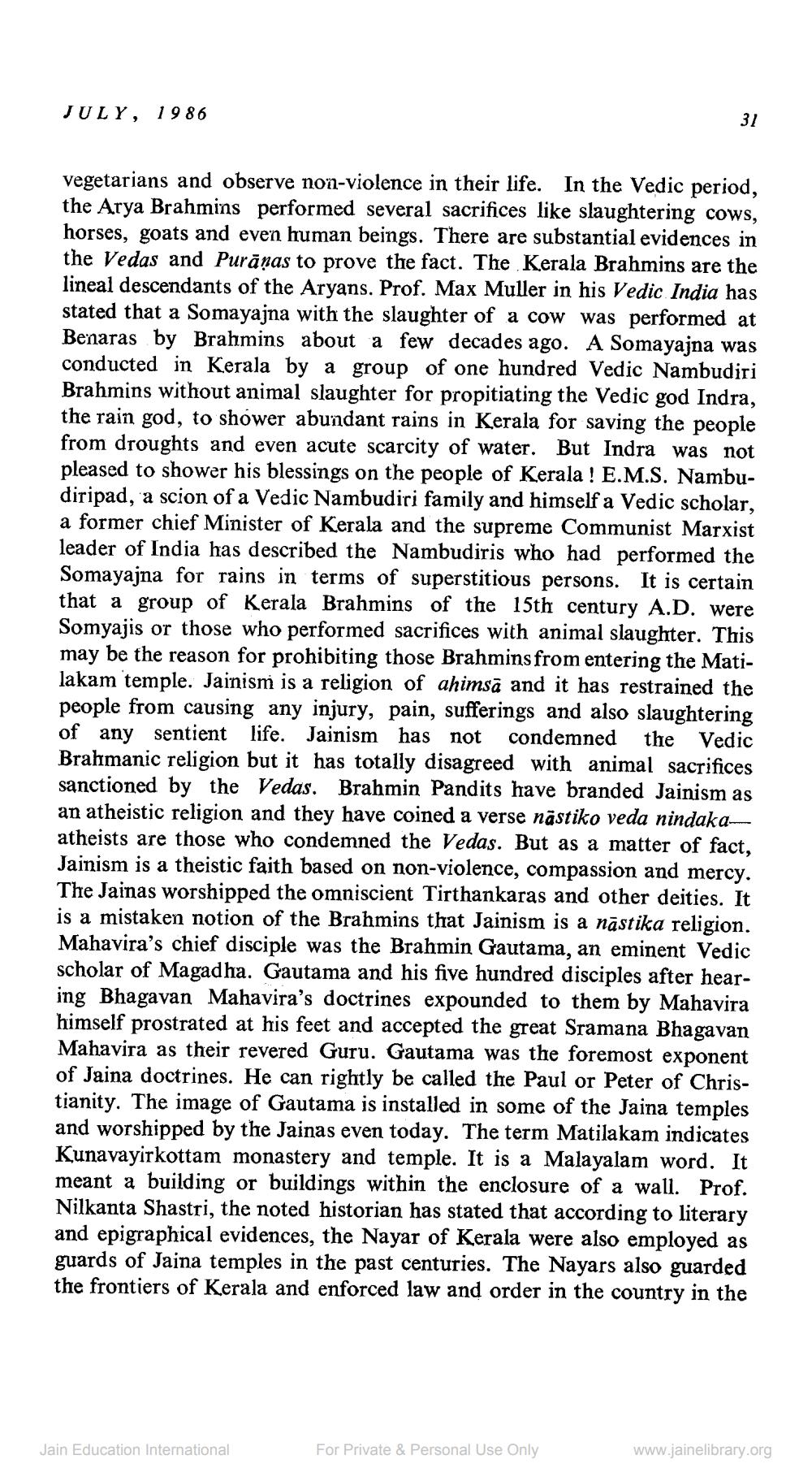________________
JULY, 1986
vegetarians and observe non-violence in their life. In the Vedic period, the Arya Brahmins performed several sacrifices like slaughtering cows, horses, goats and even human beings. There are substantial evidences in the Vedas and Purānas to prove the fact. The Kerala Brahmins are the lineal descendants of the Aryans. Prof. Max Muller in his Vedic India has stated that a Somayajna with the slaughter of a cow was performed at Benaras by Brahmins about a few decades ago. A Somayajna was conducted in Kerala by a group of one hundred Vedic Nambudiri Brahmins without animal slaughter for propitiating the Vedic god Indra, the rain god, to shower abundant rains in Kerala for saving the people from droughts and even acute scarcity of water. But Indra was not pleased to shower his blessings on the people of Kerala ! E.M.S. Nambudiripad, a scion of a Vedic Nambudiri family and himself a Vedic scholar, a former chief Minister of Kerala and the supreme Communist Marxist leader of India has described the Nambudiris who had performed the Somayajna for rains in terms of superstitious persons. It is that a group of Kerala Brahmins of the 15th century A.D. were Somyajis or those who performed sacrifices with animal slaughter. This may be the reason for prohibiting those Brahmins from entering the Matilakam temple. Jainism is a religion of ahimsā and it has restrained the people from causing any injury, pain, sufferings and also slaughtering of any sentient life. Jainism has not condemned the Vedic Brahmanic religion but it has totally disagreed with animal sacrifices sanctioned by the Vedas. Brahmin Pandits have branded Jainism as an atheistic religion and they have coined a verse năstiko veda nindaka“ atheists are those who condemned the Vedas. But as a matter of fact, Jainism is a theistic faith based on non-violence, compassion and mercy. The Jainas worshipped the omniscient Tirthankaras and other deities. It is a mistaken notion of the Brahmins that Jainism is a năstika religion. Mahavira's chief disciple was the Brahmin Gautama, an eminent Vedic scholar of Magadha. Gautama and his five hundred disciples after hearing Bhagavan Mahavira's doctrines expounded to them by Mahavira himself prostrated at his feet and accepted the great Sramana Bhagavan Mahavira as their revered Guru. Gautama was the foremost exponent of Jaina doctrines. He can rightly be called the Paul or Peter of Christianity. The image of Gautama is installed in some of the Jaina temples and worshipped by the Jainas even today. The term Matilakam indicates Kunavayirkottam monastery and temple. It is a Malayalam word. It meant a building or buildings within the enclosure of a wall. Prof. Nilkanta Shastri, the noted historian has stated that according to literary and epigraphical evidences, the Nayar of Kerala were also employed as guards of Jaina temples in the past centuries. The Nayars also guarded the frontiers of Kerala and enforced law and order in the country in the
Jain Education International
For Private & Personal Use Only
www.jainelibrary.org




